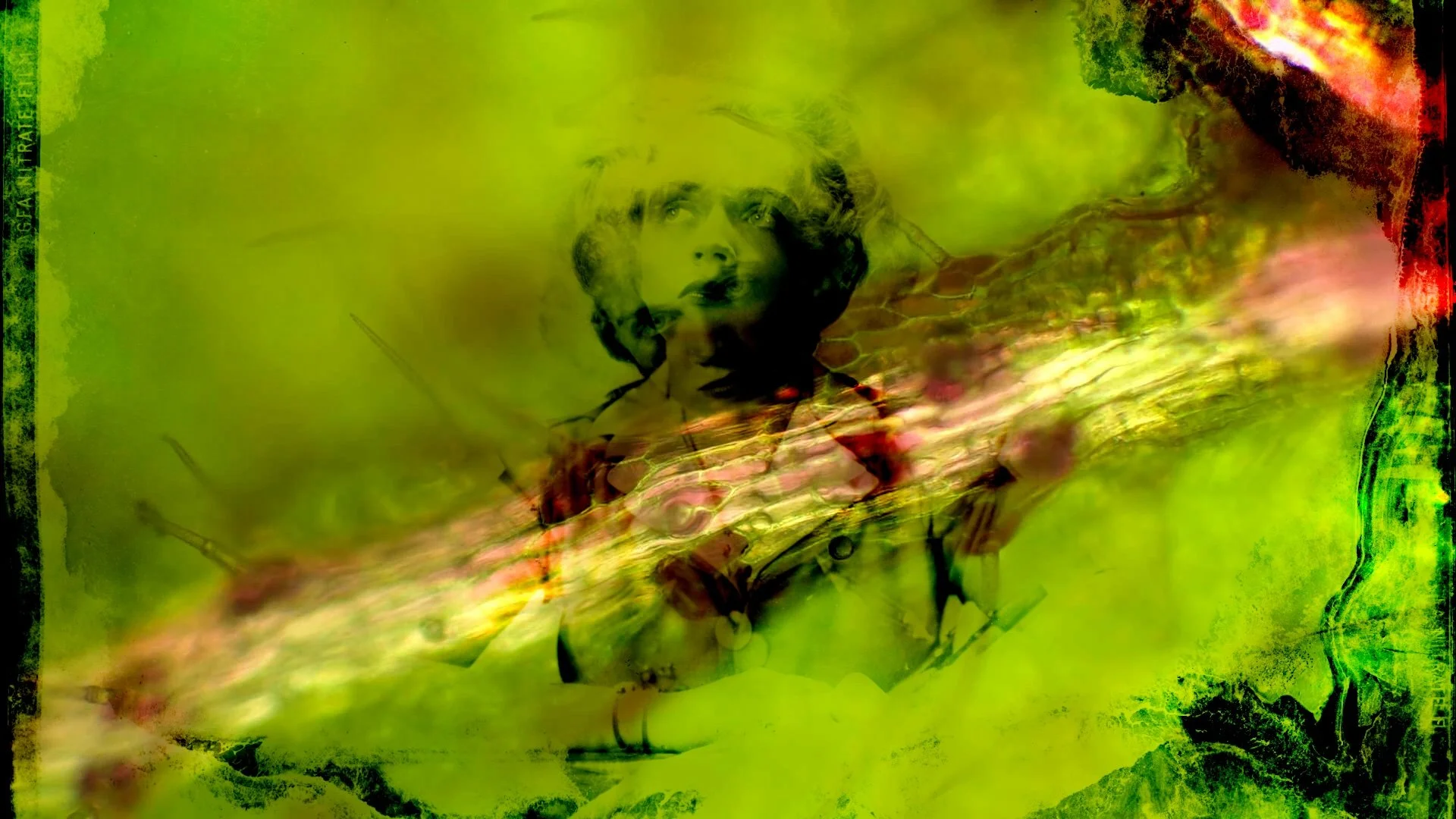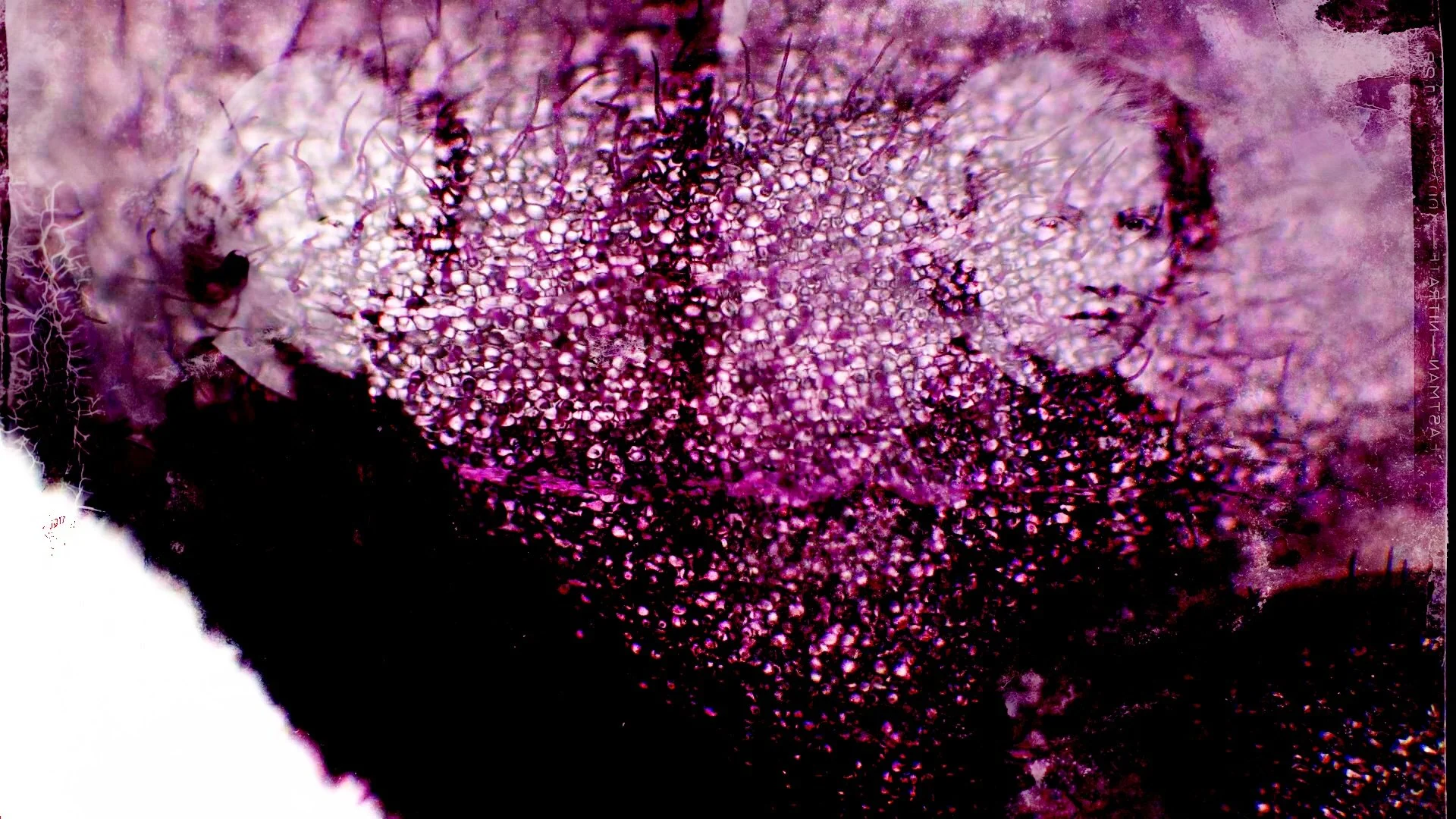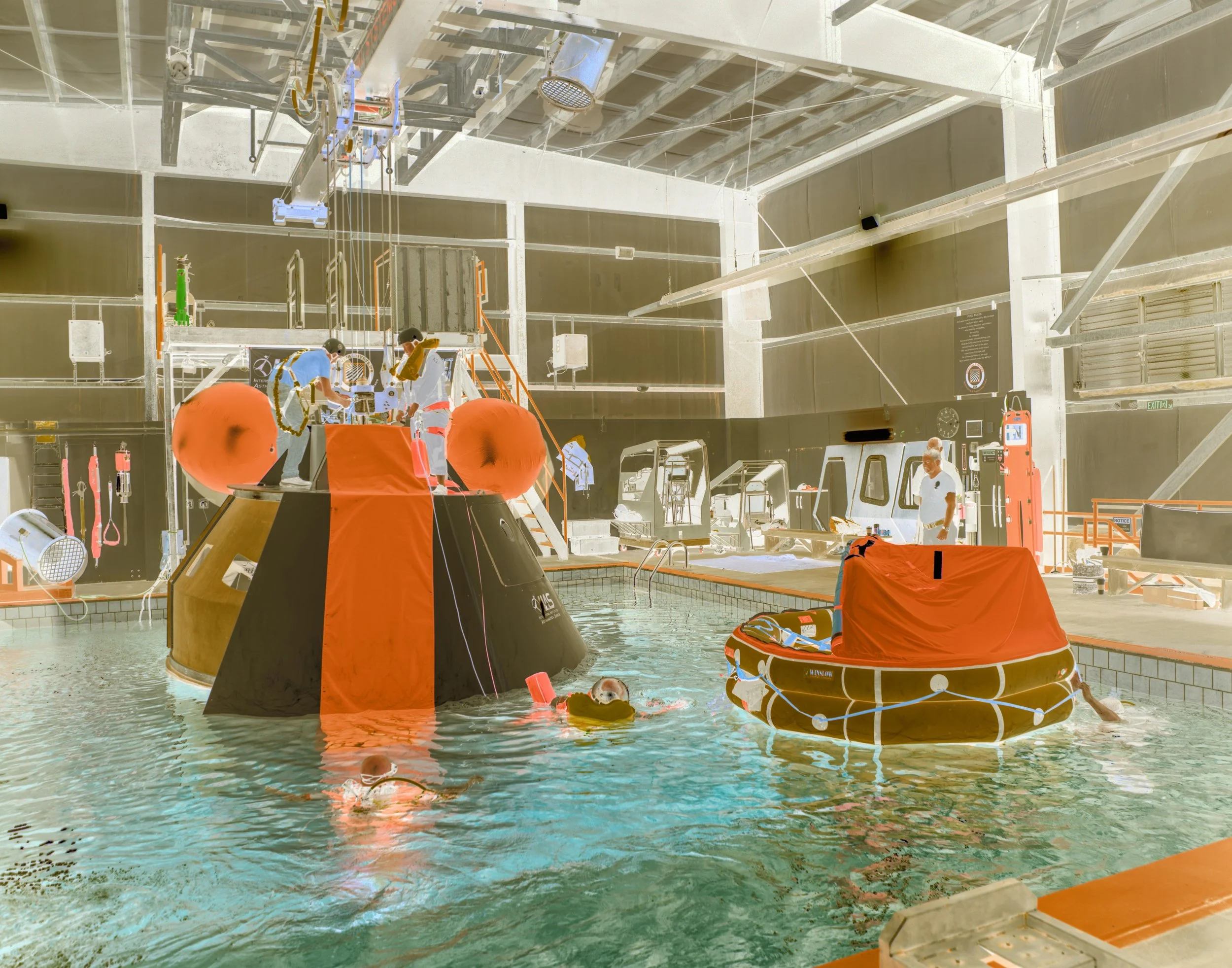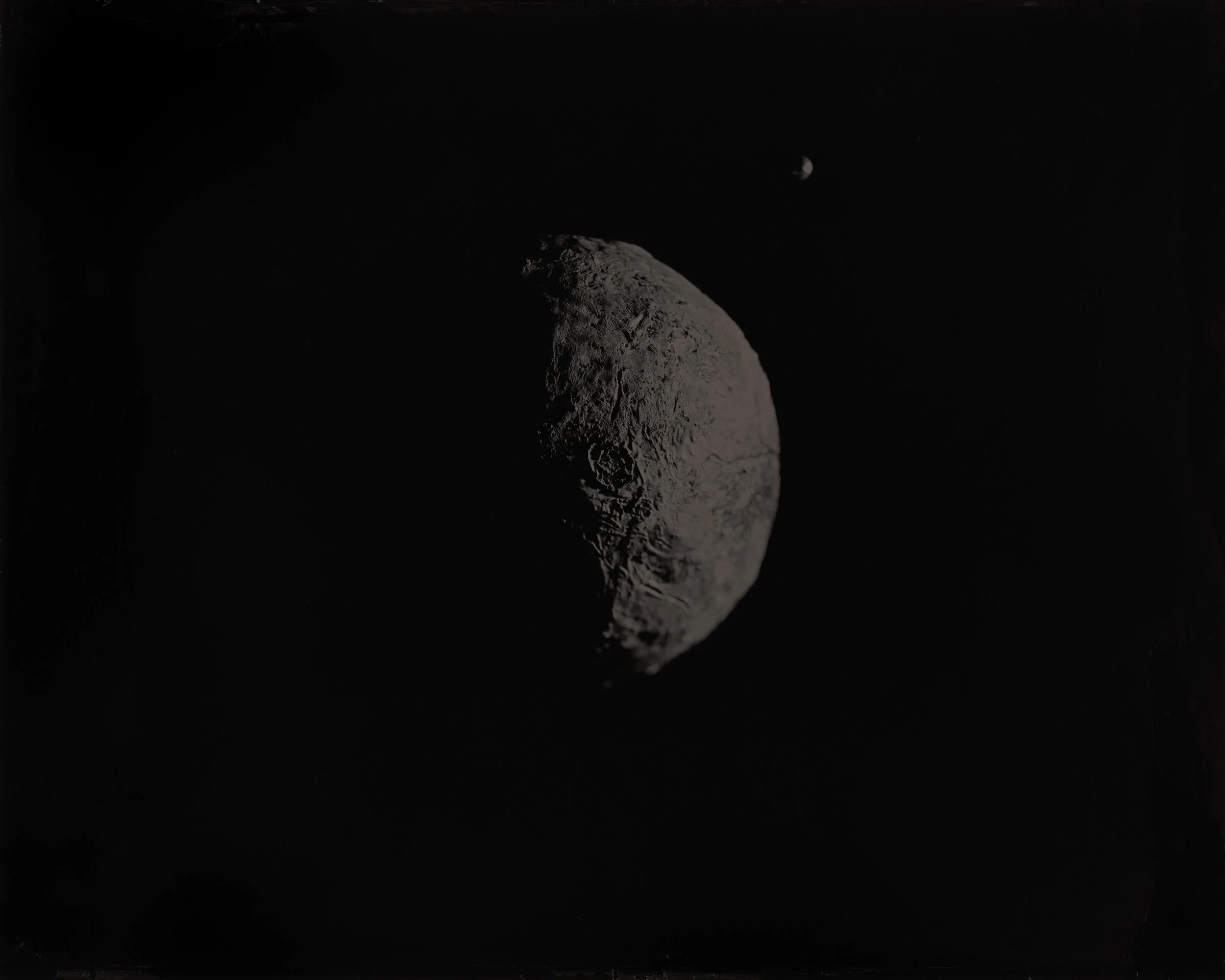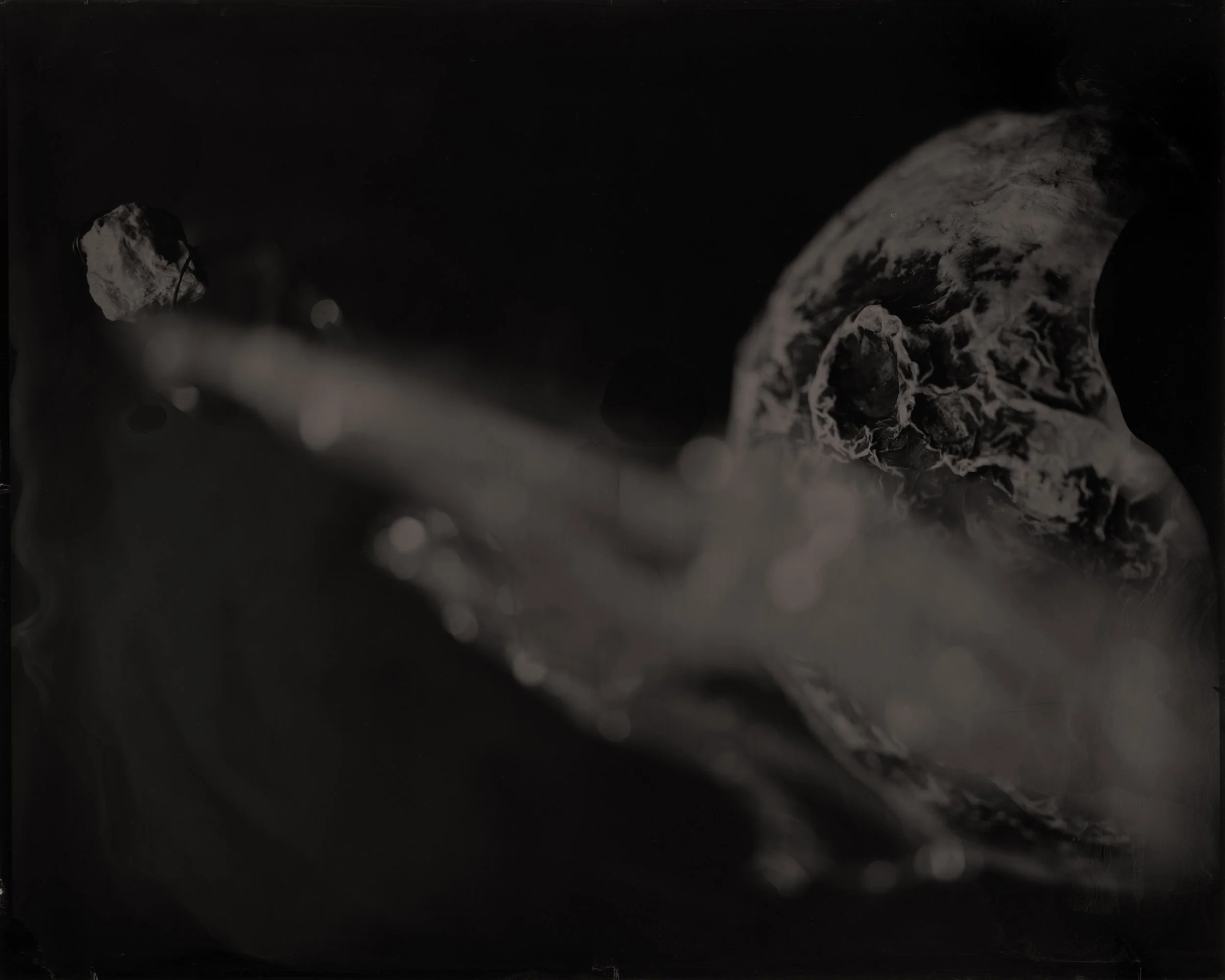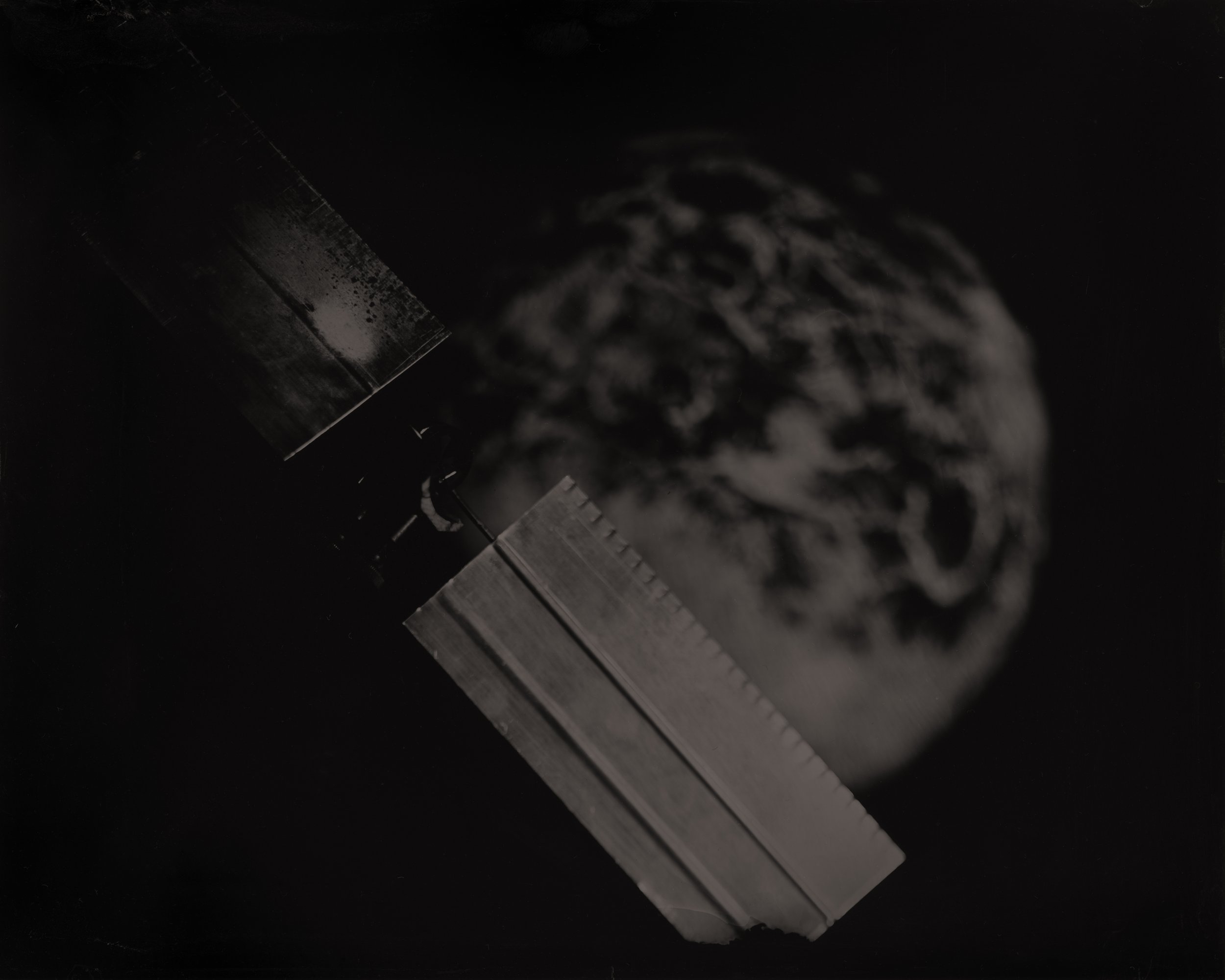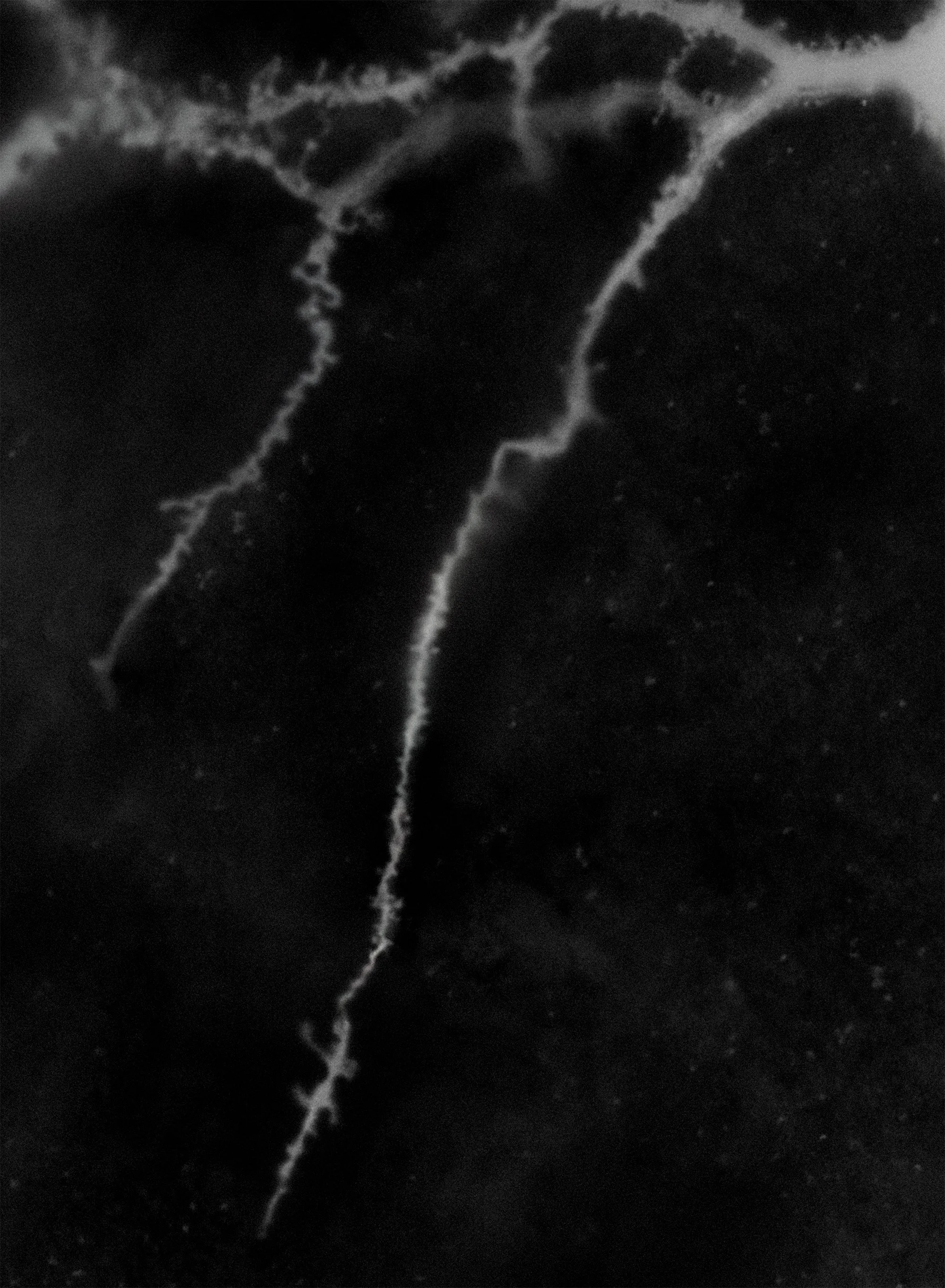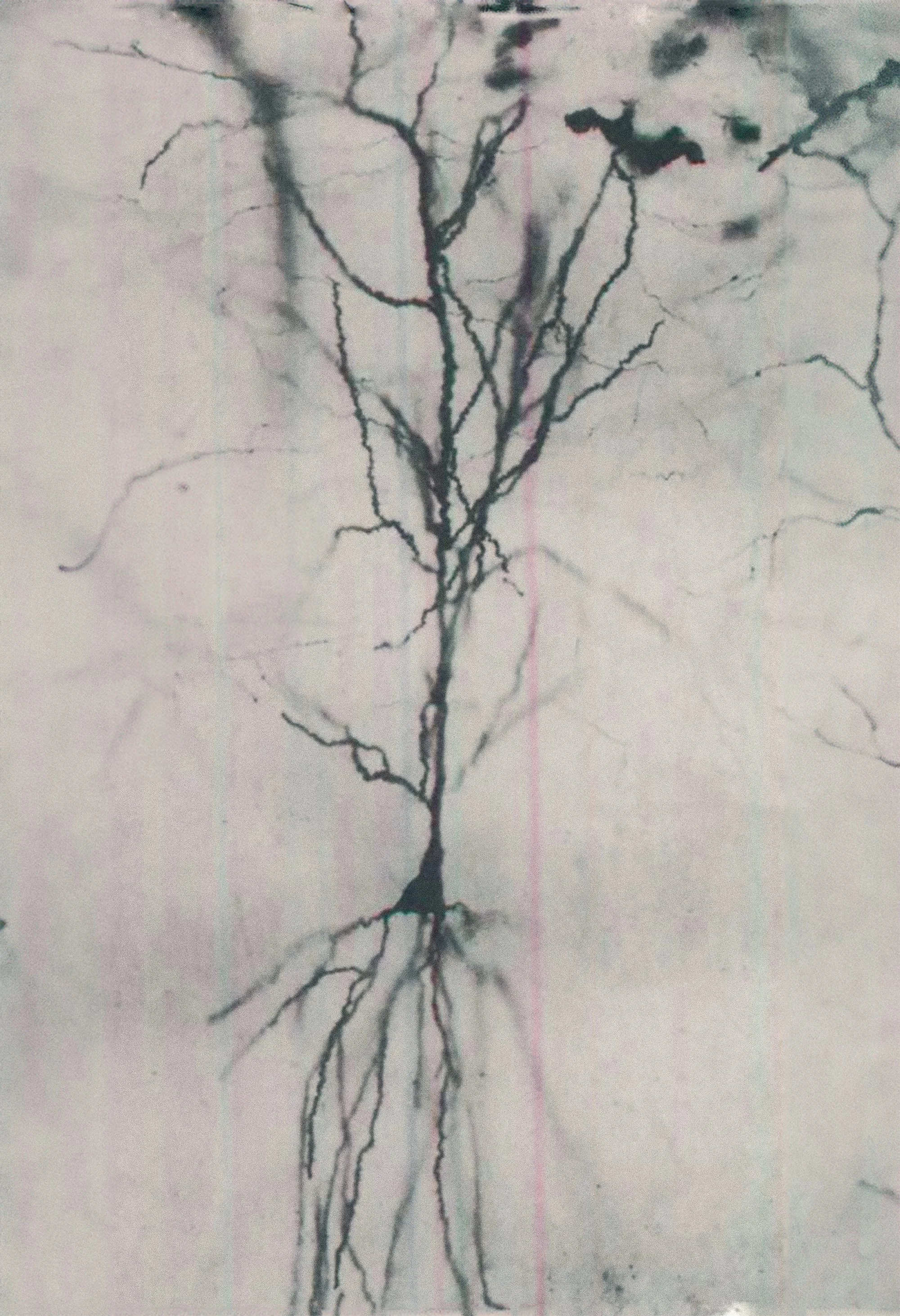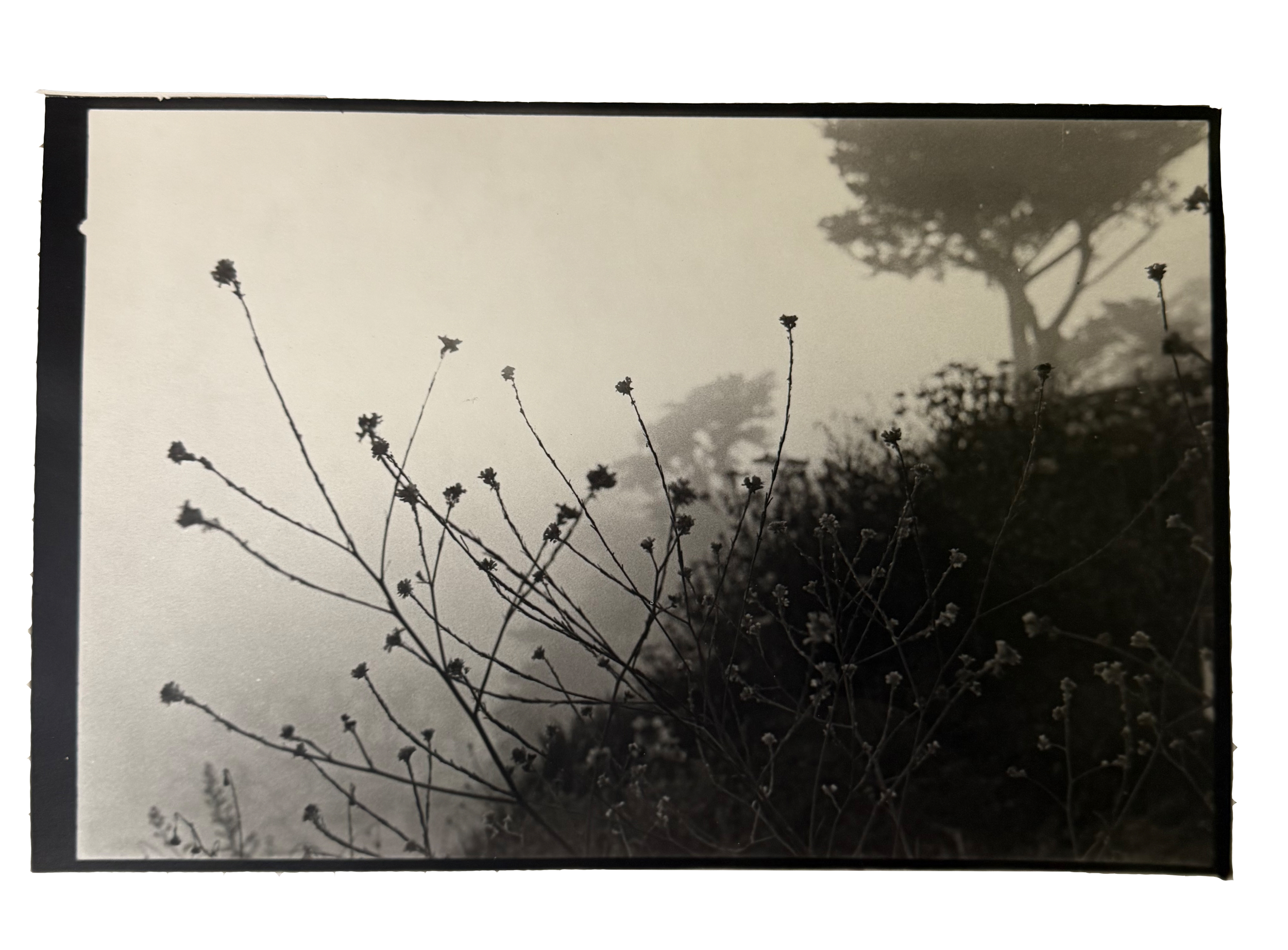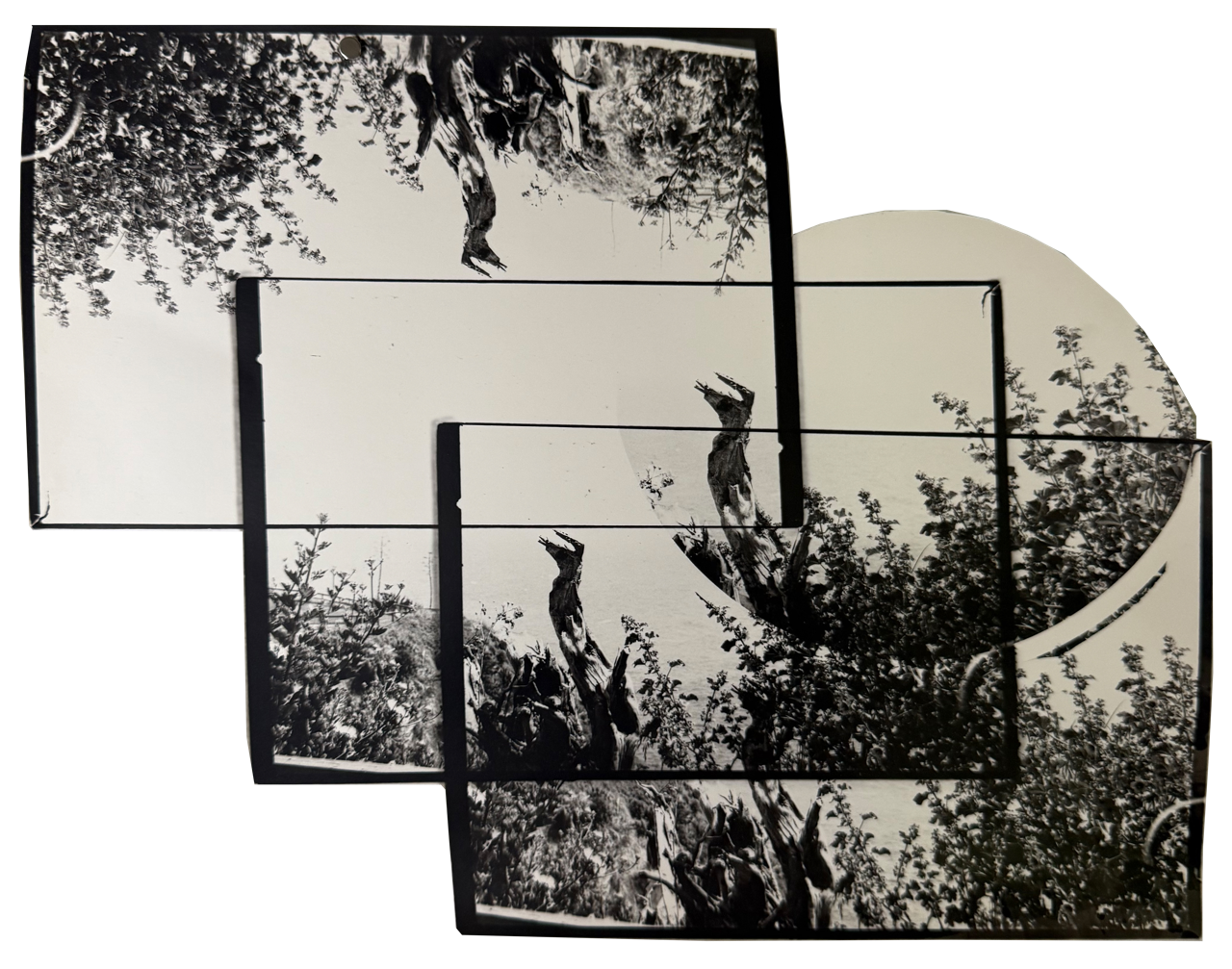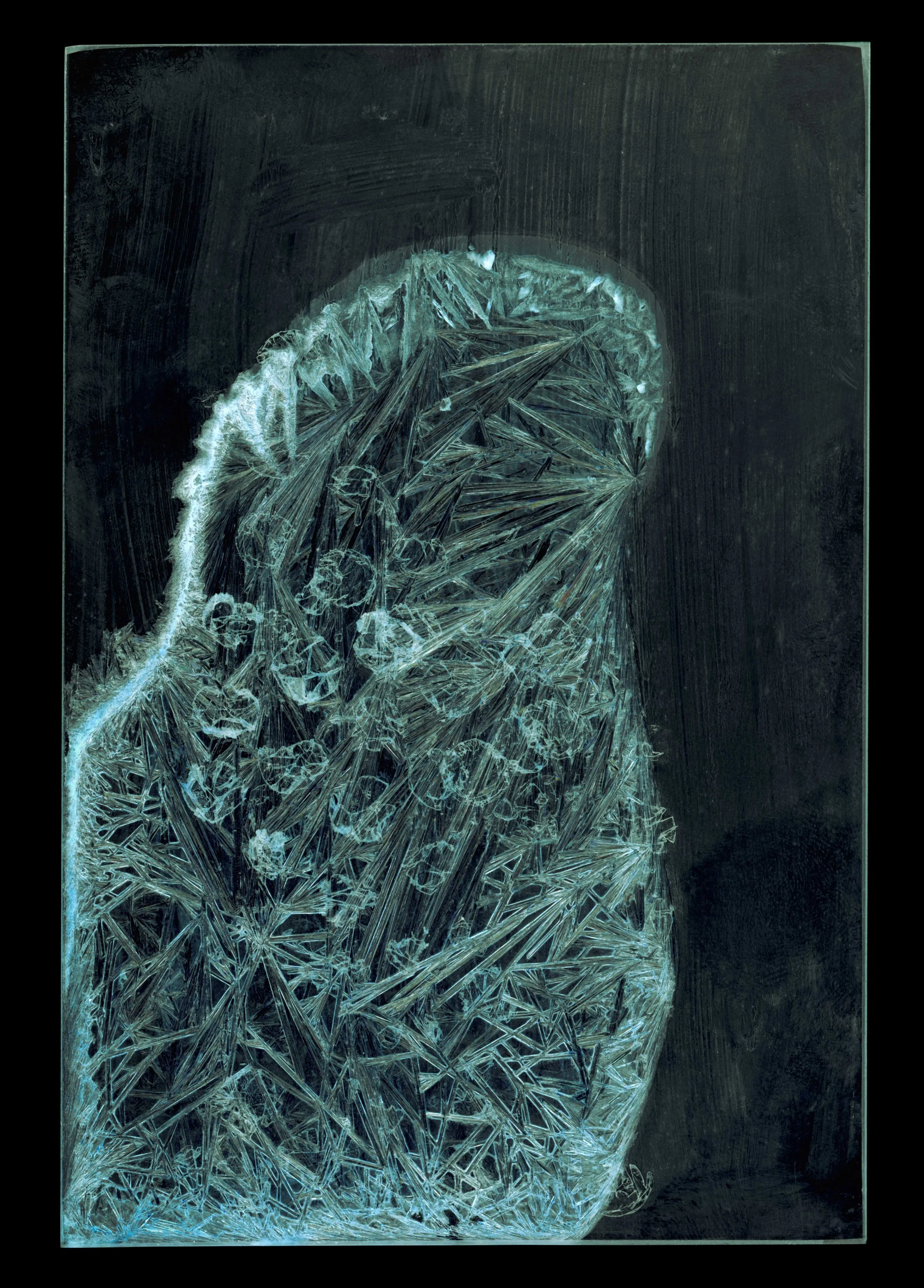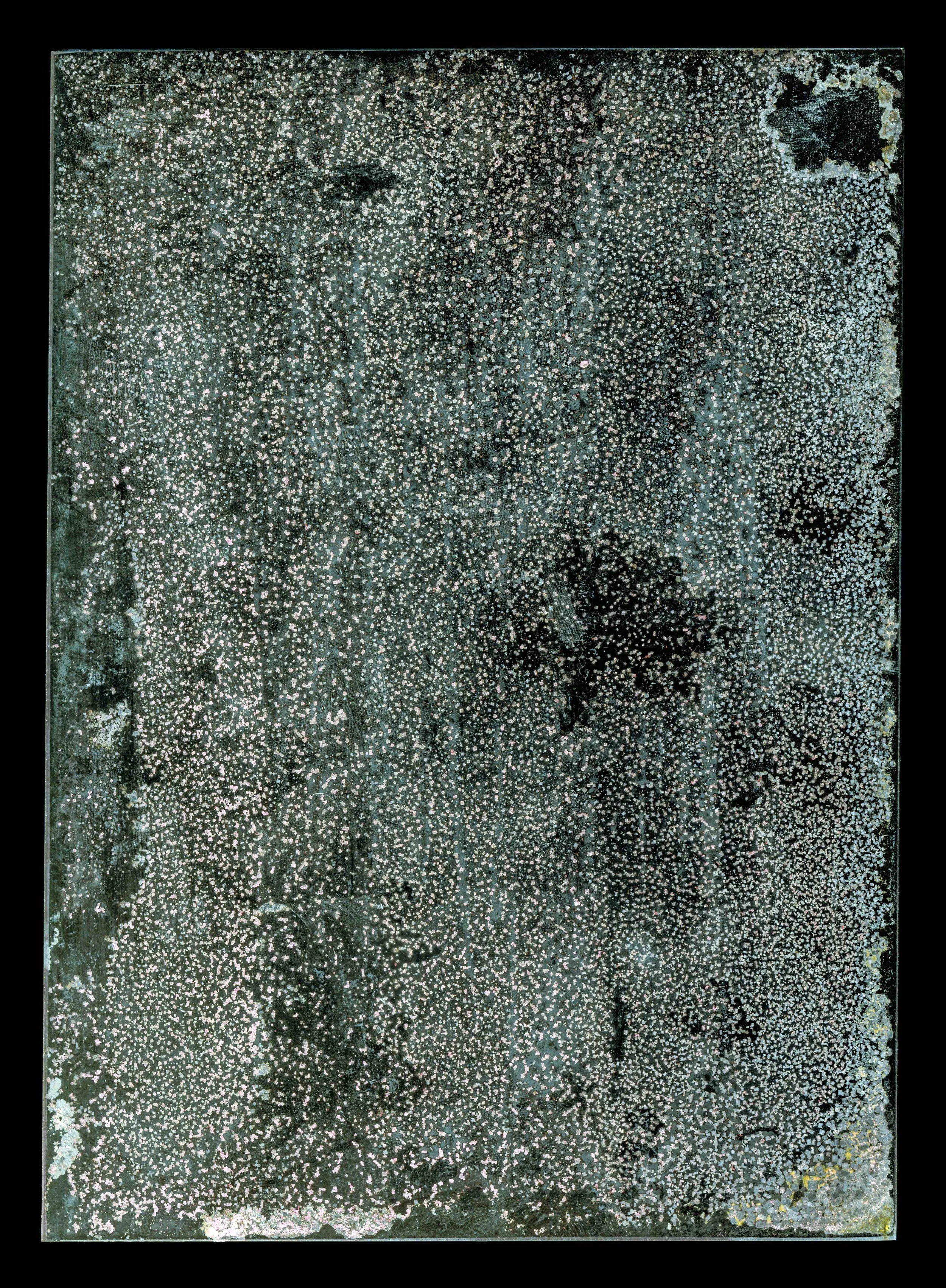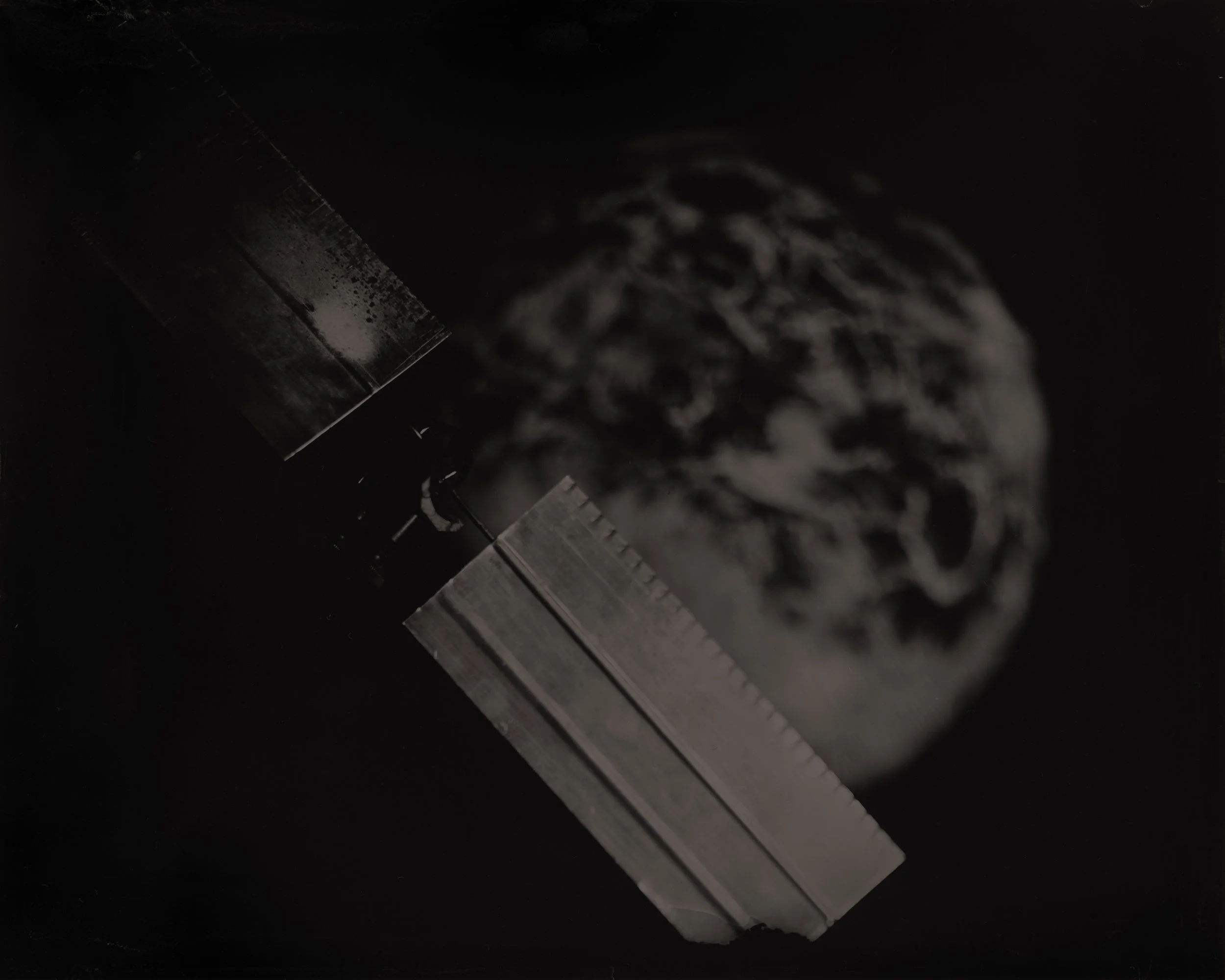
SCIENCE
GIRL
PARTY
GROUP EXHIBITION
September 5 – October 25, 2025













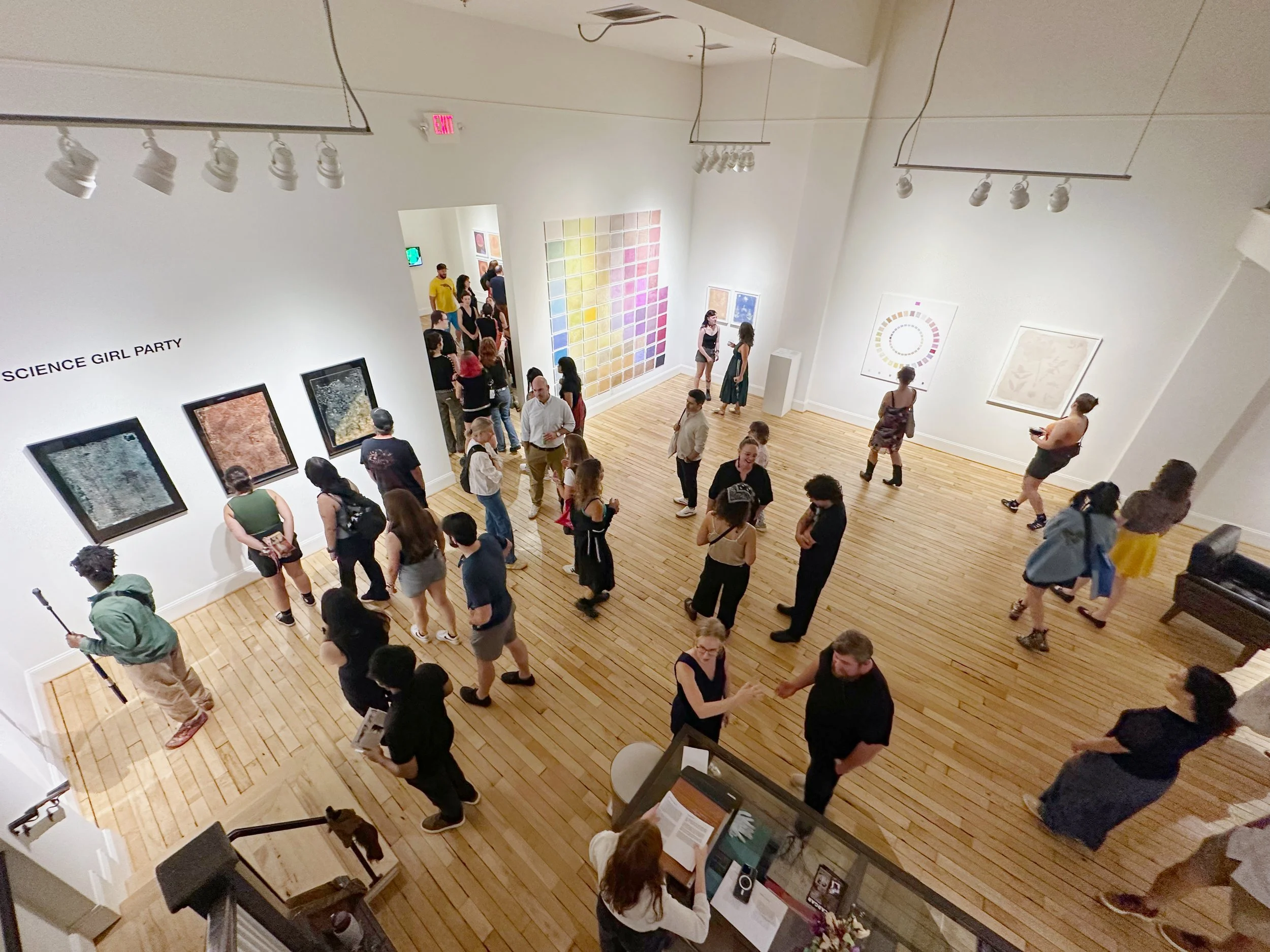
ABOUT THE EXHIBITION
Science Girl Party is a nod to the early scientific spirit of photography’s evolution through the perspective of the woman-identifying artist. Though this exhibition is a “party,” it speaks to more than just play; these artists show a proficiency in chemistry, technology, research, and craft, which they use as tools to ignite curiosity and empathy.
Including works by:
KATINA BITSICAS & SCOTT MCMAHON
MACKENZIE CALLE
ROSEMARY JESIONOWSKI
COURTNEY JOHNSON
BETH JOHNSTON
GALINA KURLAT
ANNA LAZA
DAKOTA MACE
AMANDA MARCHAND & LEAH SOBSEY
BEATRICE THORNTON
DM WITMAN
KATINA BITISICAS
& SCOTT MCMAHON
ABOUT THE WORK
In Cellulose Documents: Forget Me Not, a new purpose is given to a found archive of discarded studio portrait nitrate film negatives from the 1930’s. The crumbling and decaying negatives were preserved through digital scans and reinterpreted by the artists by combining them with microscopic imagery of botanic material. This parallels the use of cellulose in nitrate film with the makeup of organic plant cell walls. Nitrate film was used by photographers and filmmakers from the 1880s to the 1950s, but was replaced by acetate safety film after it was found to be highly flammable and unstable. By preserving these found and unidentified portraits, we illuminate the obsolete material of nitrate film through the examination of cellulose at a molecular level.
ABOUT KATINA & SCOTT
ABOUT KATINA
Katina Bitsicas is a Greek-American new media artist who utilizes video, installation, projection mapping, AR, photography, and performance in her artworks to explore grief, loss, trauma and memory. She has exhibited worldwide, including The Armory Show, Candela Books + Gallery, Plexus Projects, Wheaton Biennial curated by Legacy Russell, CADAF: Digital Art Month Paris, Torrance Art Museum, Hatch Art Center, Eye’s Walk Festival, 57th Dimitria Festival, HereArt, Art in Odd Places Orlando, Digital Graffiti Festival, Indie Memphis Film Festival and St. Louis International Film Festival. Notable residencies include Open Air Media Festival, University of Arkansas-Fort Smith Windgate AiR, UCSF Library, Atlantic Center for the Arts, Prairie Ronde, and Hinge Arts at the Kirkbride. Katina received her BA from Kalamazoo College, Post-Bacc from SACI Florence, Italy, and MFA from the University of South Florida. She is an Associate Professor within the Kinetic Imagery and Extended Reality (KIX) Lab in the Media School at Indiana University in Bloomington. She also conducts collaborative research utilizing digital storytelling as a meaning-making intervention for bereaved families and mental health promotion and policy.
ABOUT SCOTT
Scott McMahon grew up in Connecticut and now resides in Columbia, Missouri where he is an Associate Professor of Art at Columbia College. He received his MFA from Massachusetts College of Art & Design in Boston, Massachusetts, and his BFA from The University of the Arts in Philadelphia, Pennsylvania. He has completed artist residencies at Haystack Mountain School of Crafts in Deer Isle, Maine; iPark Artists’ Enclave in East Haddam, Connecticut; Border Art Residency in La Union, New Mexico and Main Street Arts in Clifton Springs, New York.
MACKENZIE CALLE
ABOUT THE WORK
NASA's Mercury, Gemini, and Apollo astronaut candidates were required to take two heterosexuality tests. In 1994, NASA asked flight surgeon Dr. Patricia Santy, "to include homosexuality as a psychiatrically disqualifying condition," for astronauts. The psychiatric team protested, but NASA insisted.
In 1983, Dr. Sally Ride became not only the first American woman in space, but she is currently recognized as the first queer astronaut. However, her sexuality would not become public until 2012 when her obituary read, "Dr. Ride is survived by her partner of 27 years, Tam O'Shaughnessy." Ride chose to keep her sexuality private and was never out in her lifetime.
A 2022 found LGBTQ+ astronauts, "perceived that being out may 'hurt their chances of getting a [Space Shuttle] flight. While three astronauts' queer sexualities have become public after going into space, NASA has never selected or flown an openly LGBTQ+ astronaut.
The Gay Space Agency confronts the American space program's historical exclusion of openly queer astronauts. The first part of the project includes documentation of queer history and manipulated NASA archival material. The second part documents aspiring LGBTQ+ astronauts and imagines a fictional space agency called the Gay Space Agency (GSA). GSA offers a counter-narrative to the history of the astronaut program and imagines a diverse and accepting future, both above and below our atmosphere.
ABOUT MACKENZIE
Mackenzie Calle is a freelance documentary photographer and National Geographic Explorer based in Brooklyn. In 2024, she was awarded World Press Photo for North & Central America, Open Format, and was a finalist for the Sony World Photography Awards.
She was selected as a Magnum Foundation Counter Histories Fellow in 2022. That same year, she was named one of the Lenscratch 25 to Watch and was shortlisted for the PhMuseum Women Photographers Grant. In 2023, she was named as a LensCulture Emerging Talent Award winner and received the Dear Dave Fellowship.
Mackenzie is a graduate of NYU’s Tisch School of the Arts with a degree in Cinema Studies and was awarded the Director’s Fellowship to attend ICP’s Documentary Practice and Visual Journalism Program. She was selected to Eddie Adams Workshop class XXXV. She is an Adjunct Lecturer at CUNY’s College of Staten Island. Prior to her freelance career, she was a photo producer at NBCUniversal.
Her work has been exhibited at Fotografiska Stockholm, Photoville, Pride Photo Festival, and Noorderlicht International Photo Festival.
Clients include National Geographic, The Washington Post, GAYLETTER, Discovery, MSNBC, and The Wall Street Journal.
ROSEMARY JESIONOWSKI
ABOUT THE WORK
All Science is Fiction Until it's Not uses wet plate collodion photographs to explore fictional planetary worlds, early discovery, alchemy, and ideas of place and communication.
ABOUT ROSEMARY
Rosemary Jesionowski was born in Portland, Oregon. She received her BFA from Ohio University in Athens, Ohio and her MFA from Indiana University in Bloomington, Indiana, both with an emphasis in photography. She has exhibited her work nationally and internationally. most notably in Daegu, South Korea, Chicago, IL, New York City, NY, Los Angeles, CA, Phoenix, AZ, Cleveland, OH, and Richmond, VA.
COURTNEY JOHNSON
ABOUT THE WORK
Dark Skies is a series of tri-color gum bichromate prints of stars in areas with low levels of light pollution, which protect the world’s ecosystems.
Gum bichromate is a full color alternative photographic process produced by hand printing three color channels of a photographic image on watercolor paper in the sun.
The prints emphasize the embedded light, mystery, and exploration of the night sky.
ABOUT COURTNEY
Courtney Johnson specializes in alternative process and experimental photography and is one of the leading scholars on the photographic cliché-verre technique. Her work has been featured in solo exhibitions in New York, Miami, San Francisco, Richmond, Colombia, and Germany and is in numerous permanent collections including the Museum of Fine Arts, Houston; University of Central Florida; Museum of Art Fort Lauderdale; and FOTOMUSEO, Bogotá. Johnson earned her BFA from New York University and her MFA from the University of Miami. She is currently an Associate Professor at the University of North Carolina Wilmington.
BETH JOHNSTON
ABOUT THE WORK
“The absence of evidence is not the evidence of absence.” – Carl Sagan
The Absence of Evidence was an art/science collaboration commissioned by the University of Colorado School of Public Medicine for a public education campaign on the impacts of high-concentration cannabis use on the developing mind.
The exhibition as a whole explored the nuanced landscape of cannabis use—acknowledging both its potential benefits and harms—while highlighting the complex political, industrial, and social forces shaping contemporary understandings of the plant. At its heart, the exhibition hoped to foster thoughtful conversations and encourage open public dialogue.
My project, The Absence of Evidence, specifically addresses the dramatic rise in THC concentrations over the last decade—from roughly 3–30% previously to as high as 90% today—and highlights critical gaps in scientific research, which exist largely due to federal regulations and industry influences.
Using archival micrographs of neurons sourced from Yale Medical School, the project visually emphasizes the neuron both as the literal site of THC’s impact and as a symbol of knowledge production. The integration of these archival images with custom-crafted wood frames and stained glass employs the visual language of scientific inquiry. This approach not only honors the insights provided by scientific research but also intentionally creates space for perspectives, experiences, and narratives that science does not currently see.
Overall, the project stresses the value of community discussions, especially given the current gaps in scientific knowledge. In the frame here, a neuron synapse is framed by stained glass, highlighting the synapse as a crucial point of communication and a symbol of knowledge exchange. It is also the literal site of THC impact.
ABOUT BETH
Beth Johnston is a research-based artist working across photography, video, text, and installation to explore the connections between ecology, cultural imaginations, and ways of knowing. Beth received an MFA in Photography from Rhode Island School of Design in 2022 with a self-designed concentration in Nature-Culture Sustainability Studies. She is currently a Colorado Art Science Environment (CASE) Fellow with the University of Colorado-Boulder and the recipient of the 2023 Denis Roussel Fellowship with the Center for Fine Art Photography. Her current research interests include queer ecology, art as activism, place-based pedagogies, and climate science.
GALINA KURLAT
ABOUT THE WORK
Vestige is a series of lumen prints in which ephemera from my body directly interacts with silver gelatin paper, creating a non-representational self-portrait. In these color-scape photograms, the female form, which is subjected to an onslaught of societal pressure and objectification, defies conventional representation, appearing as mark-making and surface disruptions on photographic paper. Lush pinks, mauves, and reds directly engage a "female" palate while subverting the recognizable for the abstract. Throughout the series, the repetition of the circle is not a direct reference to the body, but a nod to its absence.
Lumen prints are a historic photographic process; they are made by exposing silver gelatin paper to light for extended periods. The paper develops outside the darkroom, needing only sodium thiosulfate to fix the image. By making these photograms outdoors, I connect my body to the environment I live in. Day-to-day changes in light and temperature directly affect the individual print's outcome. Although these images resemble paintings, they are fundamentally photographic; the colors and their variations directly relate to the type of paper used, exposure time, and UV in the light source.
This project is a natural extension of my work with figurative and portrait photography. Instead of a classic depiction of my body, these images reinterpret the gaze by eliminating sensuality (the body) for the sublime (abstraction), creating a new self-portrait while challenging representation of the corporeal. Here, the physical remnants of my body are an affirmation and serve as evidence of my existence. These images become a collaboration between process and intention while addressing themes of identity, mortality, and the body from a uniquely female perspective.
ABOUT GALINA
Galina Kurlat (b. 1981, Russia) is a photographic artist living in Brooklyn, NY, she earned her BFA in Media Arts from Pratt Institute. Kurlat creates a visual relationship between herself and her subject by embracing the imperfections and possibilities of antiquated photographic processes. Her works undulate between the recognizable and the ephemeral. By accepting the change and chaos inherent in photographic materials Kurlat challenges photography as a historically representational medium.
Kurlat’s work has been shown in Korea, India, Scotland, France and the US. Recent exhibitions include "Traces", in Louisville, Kentucky, "Vestige", treat gallery at VOLTA in NYC, “Shadow Play”, Peter Halpert Fine Art in NYC, “Process”, Studio Bizio in Edinburgh, “Touch me Touch you”, Jinju International Photo Festival, South Korea, “Self-Processing- Instant Photography”, Ogden Museum of Southern Art in New Orleans, LA. Her work is collected throughout the US and abroad.
Kurlat has been published in Oxford American, Fraction Magazine, Houston Chronicle, Diffusion IX and Fraction of a Second, Radius Books along with numerous other periodicals and catalogs. She is the cofounder of Main Street Projects, an artist-run organization in Houston which has hosted over 150 local, national and international artists to date. MSP is an artists’ initiative which brings art into urban surroundings.
During 2005-2011 Kurlat curated a number of multi-media and site specific exhibitions in alternate spaces throughout NYC.
ANNA LAZA
ABOUT THE WORK
Blue Bayou
"They are among us."
Mysterious flying objects over New Jersey in late 2024 reignited global attention surrounding a phenomenon that has persisted for nearly two decades, with authorities citing security threats.Yet, no location on Earth has reported more extraterrestrial activity than the remote island of Cyprus.
Project code-named "Blue Bayou" deployed military-grade systems like XM25 and HELLADS, uncovering non-human artifacts and traces. Advanced surveillance detected electromagnetic anomalies, unexplained equipment failures, and various physical and psychological effects on local residents. Data was shared with top authorities, including the Habitable Worlds Observatory.
Security footage captured circular lights morphing into ghostly figures, seemingly attempting contact with locals. Witnesses reported episodes, including telepathic communication and ultrasonic interactions with the luminous figures. A key case, Contactee #116, described a March encounter with a shape-shifting object emitting a paralyzing light, leading to a time lapse and enhanced sensory abilities, Contactee was found repeating phrase "They are among us.”
Subsequent social media research revealed similar global incidents, aligning temporally with the Cyprus events.
The question remains: what are they, and why are they here?
UAP SC Task Force
Sector 7
ABOUT ANNA
Anna Laza is a visual artist renowned for her Art and Semi-Scientific photography, delving into mysterious phenomena, capturing what is unseen. Through innovative techniques in both shooting and post-processing (with no use of AI), her work pushes artistic boundaries, offering a glimpse into hidden dimensions. Her work has been rewarded and has been exhibited internationally in many countries around the world, she has won in a number of famous photo contests, including LensCulture, Minimalist Awards and others. She is often published in photography magazines and regularly appears on prestigious jury lists for photographic events, such as Street Photo Awards and MonoVisions.
Beside her own photography she is also a creator of photo magazine FotoSlovo, which promotes every year new emerging talents in photography.
Represented in Studio Idan, Albumen Gallery, Ionnyk, Artsper and Saatchi.
DAKOTA MACE
ABOUT THE WORK
Łichíí (Red) Series is dedicated to Missing and Murdered Indigenous women. Their stories continue to exist within the landscape and impact our relationship with these sacred places. Through their memories, may we never forget who they were: mothers, grandmothers, sisters, aunts, nieces, and daughters.
Creating this work started with listening to the stories of those whose families had gone missing or were murdered. With each story, the importance was placed on the memories of those individuals and places that held significance for them. As a result, a more profound appreciation of these individual's strengths inspired me to reflect on what it means to be connected to the land.
Each piece was dedicated to these stories, places that hold memories or are abstractions of their home. The work was also created to be eventually placed back into the earth. The original works have slowly deteriorated over time, with the emulsion slowly peeling and separating while the dye takes over the entire image. I intended to see this work as an extension of those who were no longer with us, a chance to live through the work and slowly go home, becoming one with the landscape. As an artist and someone who works in the museum field, this went against everything I learned in terms of preservation, but it also was a starting point for me to see my work past its material presence.
Through the stories of MMIW and looking at our shared histories, I realized the significance of creating work that has a timeline. Like my ancestors, our stories eventually go back into the land to be shared and honored. This work was what inspired my later series, titled Sacred Places, and looked at the significance of oral narratives and photography.
ABOUT DAKOTA
Dakota Mace (Diné) is an interdisciplinary artist who focuses on translating the language of Diné history and beliefs. Mace received her MA and MFA degrees in Photography and Textile Design at the University of Wisconsin-Madison and her BFA in Photography from the Institute of American Indian Arts. As a Diné (Navajo) artist, her work draws from the history of her Diné heritage, exploring the themes of family lineage, community, and identity. In addition, her work pushes the viewer's understanding of Diné culture through alternative photography techniques, weaving, beadwork, and papermaking.
She has also worked with numerous institutions and programs to develop dialogue on cultural appropriation and the importance of Indigenous design work. She is an MFA in Studio Arts Faculty member at the Institute of American Indian Arts and the photographer for the Helen Louise Allen Textile Center and the Center of Design and Material Culture.
Her work is in the collections of the Library of Congress, Forge Project Collection, Whitney Museum of American Art, Everson Museum of Art, Amon Carter Museum, National Gallery of Art, Museum of Contemporary Photography among other public collections.
AMANDA MARCHAND
& LEAH SOBSEY
ABOUT THE WORK
Beginning in the 2020 pandemic, Amanda Marchand and Leah Sobsey began collaborating on This Earthen Door, a work documenting their encounter with poet Emily Dickinson’s herbarium. The resulting artwork is not a copy of the original but an entirely new and incandescent work of and for our time.
Published only after her death, the iconic 19th century poet was better known as a gardener and budding botanist during her lifetime. Over one third of her poems and half her letters reference flowers and plants, illuminating her deep connection to the natural world. In a gesture honoring her nearly 200-year-old effort, the artists grew and harvested plants from her garden to remake her flower sampler with an early 19th century photo process known as anthotype.
Anthotypes (from the Greek meaning flower) are plant-based photographs. The sun’s rays have both a chemical and bleaching effect, leaving a shadow imprint on paper, a slow-to-expose, camera-less sun-print. This eco feminist collaboration provides a portal through which to examine our changing environment, and revives exciting possibilities of working with non-toxic, sustainable photography. With permission from Harvard’s Houghton Library, the artists used the existing digital archive to reproduce Dickinson’s book of flowers. The series highlights the importance of archives and the scientific/artistic contributions of women.
This Earthen Door is a two-part work, in conversation with scientists and Dickinson scholars, forging a necessary connection between literature, art, and ecology. Part I, HERBARIUM reanimates Emily Dickinson’s original herbarium, a book now too fragile to be viewed again. The 66 botanical prints reflect a cacophony of non-synthetic hues derived from nature. Part II, CHROMOTAXIA, is both color sampler and research project, including 33 abstract images that address vital stories about the poet, climate, gardens, and ecology. What can we learn about our current world from this unique, nearly forgotten archive? How can this work entice us to engage, as Dickinson once did, through slow, deliberate attention to the natural world? This work provides a glimpse into the nature-inspired world of the enigmatic poet and asks where she might point us in this moment of “plant invisibility” and climate chaos.
ABOUT AMANDA & LEAH
AMANDA MARCHAND is a Canadian artist and educator living in New York. Her work focuses on the natural world with an experimental approach to photography. Recent honors include the 2024 Lensculture Awards winner; the 2024 London Photography Awards; the 2023 Julia Margaret Cameron Photography Awards; the 2022 Silver List (Silver Eye Center for Photography and Carnegie Mellon); Medium Photo Festival’s Second Sight Award Winner, 2021; Photo Lucida’s Critical Mass Top 50, 2021. She has held fellowships at the Hermitage Artist Retreat, MacDowell Colony, Mass MoCA, and Headlands Center for the Arts, among others.
Marchand’s work has been exhibited internationally in solo and group shows. “This Earthen Door” premiered at Photofairs NYC 2023, was exhibited at the Stephen and Peter Sachs Museum, and will be on view at the Brandywine Museum of Art, 2025. Marchand has published three monographs with Datz Press, “This Earthen Door: Emily Dickinson’s Herbarium,” (2024); "Nothing Will Ever be the Same Again" (2019); and "Night Garden" (2015). She has published several artist books including, "The World is Astonishing with You in it: A 21st Century Field Guide to the Birds, Ferns and Wildflowers," (2022). Her work is collected internationally in private and public collections such as, The Getty Research Institute, Stanford University Library, San Jose Museum of Art, the Center for Creative Photography, and the Cleveland Museum of Art. Her work has been reviewed in The Marginalian, Lenscratch, Lensculutre, and ARTnews. “This Earthen Door” is represented by Rick Wester Fine Art. Marchand is represented by Traywick Contemporary, Rick Wester Fine Art, and photo-eye Gallery’s Showcase.
LEAH SOBSEY is an artist, Associate Professor of Photography, Curator, and Director of the Gatewood Gallery at the University of North Carolina, Greensboro. Her multidisciplinary photographic practice reaches into the fields of nature and science, design, installation, and textile. Recent exhibitions include Paris Photo, the Huntington Museum CA, Datz Press Seoul Korea, The Sachs Museum St Louis, The Harvard Museum of Natural History, with forthcoming solo exhibitions in 2025 at the Brandywine Museum of Art, AIPAD NYC, Rick Wester Fine Art NYC, the Gregg Museum and National Chengchi University, Taipei. Her books include This Earthen Door - Datz Press, 2024. Collections: Birds Bones and Butterflies, 2016, and Bull City Summer, 2013.
Sobsey has exhibited internationally, and her works are held in private and public collections across the US. She has participated in numerous artist residencies, including the Virginia Center for the Arts, Dumbarton Oaks, Penland, The National Park system, Hambidge, and Habla Mexico. Her work has been published in Artnews, New Yorker.com, the Paris Review Daily, Slate.com, Hyperallergic, The Telegraph, The Marginalian, and Audubon. This Earthen Door is represented by Rick Wester Fine Art.
BEATRICE THORNTON
ABOUT THE WORK
Balsamic Time features recent plant-developed gelatin silver fiber prints by Oakland-based artist, archivist, and historian Beatrice Thornton. Beatrice’s practice centers on using sustainable darkroom processes to develop film and make prints using homemade chemistry from foraged plants to communicate ideas about place with geometric arrangements of exposures on a single sheet of paper.
This installation at the gallery in Small Works SF includes a series of multi-image compositions made from 35mm gelatin silver film shot mostly while hiking along the California coast and in Mexico City. The works, or “balsamic moments,” climb across the gallery walls, intersecting to form diagonals and zig-zags.
Balsamic Time is an herbalist practice for harvesting plants when their healing properties are most potent. It is also the final waning crescent of the lunar chart and considered a period of introspection. To make each of her film and print developers, Beatrice brews a tea from foraged plants specific to the locations pictured but also mindful of the plants’ medicinal uses as they might relate to her imagery. For instance, mugwort is commonly used to induce dreaming.
These works reconsider the frame — both as it appears on a roll of film and the rectilinear format in which photographs are typically printed in the darkroom— through her use of overlapping negative frames and circular masks to obscure and create alternative experiences of the same image through repetition. Her work also considers relationships to place through references to art and design history, poetry, and Buddhist and environmental concepts, mingled with biographical details.
ABOUT BEATRICE
Beatrice is an Oakland-based land artist, archivist, historian, and darkroom instructor working in black-and-white film photography through sustainable, alternative darkroom processes equally in dialogue with place and medium. Since moving back to the Bay Area from New York in 2018, she has been exploring ways that reconnect her to her home state — along the way learning, questioning, and considering its complex histories with a sense of wonder spanning , bioregionalism, art and design history, archival methods, and darkroom-based graphic design.
Thornton develops film and prints in her home darkroom, creating developer recipes using ingredients including foraged plants, collected rainwater, and low-toxicity household ingredients in place of traditional darkroom chemistry.
Her photographic style often features landscapes and architecture through in-camera double exposures and in-darkroom graphic design. She pairs developers with plants featured in, or that grow within the environments pictured. She sees developing with plants as a circular process where the art produced is as much about process as it is the final objects.
Beatrice holds a BA in art history and French from New York University and took darkroom courses at Parsons School of Design and NYU. She received an MA in decorative arts, design history, and material culture from Bard Graduate Center, and holds a certificate in archives and records management from Long Island University. She grew up in Mill Valley and lives in Oakland, CA. Her work is included in private collections and has been exhibited locally in the Bay Area.
DM WITMAN
ABOUT THE WORK
Ecologies of Restoration consists of images documenting the growth salt cultures on glass. The project, a continuation of Witman’s Ecologies of Mourning, is a personal exploration of healing and resiliency as a counter to experiences of loss and grief.
There are many types of salts, just as there are many reasons for grief, however each salt compound has an inherent crystalline structure that is influenced by its environment and can yield new possibilities. These images provide meditations for building, mending, and reconfiguring – of ourselves and the world around us.
ABOUT DM
DM Witman is a transdisciplinary artist navigating the polycrisis employing photographic materials, video, and installation. Her practice investigates climate disruption–at the intersection of presence/absence, resiliency, and ecology–relying on both archival impulses and ephemerality. Her creative practice is an act of bearing witness, memorial, and synthesizing that which is existentially urgent–at once both a lament for what has been lost, and a call to action to cultivate care and resilience as stewards for what remains.
Her work has appeared in more than 120 solo and group exhibitions nationally and internationally. She has been selected for artist-residencies such as Ellis-Beauregard Foundation in Rockland, Maine; Monson Arts, Maine; How to Flatten A Mountain, Ireland.
Witman’s work resides in the permanent collections of the Museum of Fine Arts Houston, Portland Museum of Art, Portland, Maine, and is placed within many private collections. She is affiliated with photo-eye Gallery, Santa Fe, NM and Maine Museum of Photographic Arts, Portland, Maine. Interviews and publications include Inside Climate News, The Guardian, BBC Culture, and WIRED. Her work has been recognized with grants from the Maine Arts Commission, The Kindling Fund and the Warhol Foundation), The John Anson Kittredge Fund, and the Puffin Foundation.
Witman received her MFA from Maine Media College and she holds a BS in Environmental Science from Kutztown University. She splits her time between the Borderlands of South Texas and Midcoast Maine. She is currently Assistant Professor of Photography at University of Texas Rio Grande Valley.
